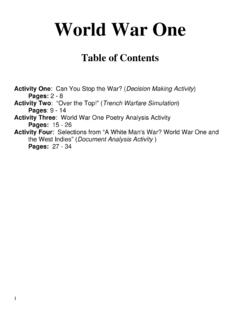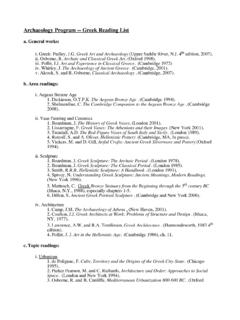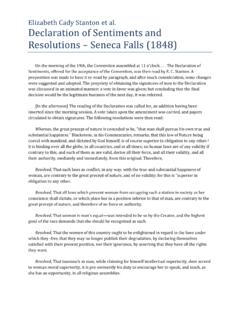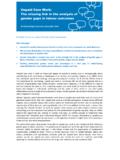Transcription of Missing Data & How to Deal: An overview of missing data
1 Missing data & How to Deal: An overview of Missing dataMelissa HumphriesPopulation Research CenterGoals Discuss ways to evaluate and understand Missing data Discuss common Missing data methods Know the advantages and disadvantages of common methods Review useful commands in Statafor Missing dataGeneral Steps for Analysis with Missing data 1. Identify patterns/reasons for Missing and recode correctly 2. Understand distribution of Missing data 3. Decide on best method of analysisStep One: Understand your data Attrition due to social/natural processes Example: School graduation, dropout, death Skip pattern in survey Example: Certain questions only asked to respondents who indicate they are married Intentional Missing as part of data collection process Random data collection issues Respondent refusal/Non-responseFind information from survey (codebook, questionnaire) Identify skip patterns and/or sampling strategy from documentationRecode for analysis: mvdecodecommand Mvdecode How statareads Missing Tip.
2 ># s NmissingnpresentRecode for analysis: mvdecodecommand Mvdecode How statareads Missing Tip .># s NmissingnpresentNote: Statareads Missing (.) as a value greater than any Missing data patterns: misstablecommandStep Two: Missing data Mechanism (or probability distribution of missingness) Consider the probability of missingness Are certain groups more likely to have Missing values? Example: Respondents in service occupations less likely to report income Are certain responses more likely to be Missing ? Example: Respondents with high income less likely to report income Certain analysis methods assume a certain probability distributionMissing data Mechanisms Missing Completely at Random (MCAR) Missing value (y) neither depends on x nor y Example: some survey questions asked of a simple random sample of original sample Missing at Random (MAR) Missing value (y) depends on x, but not y Example: Respondents in service occupations less likely to report income Missing not at Random (NMAR) The probability of a Missing value depends on the variable that is Missing Example.
3 Respondents with high income less likely to report incomeExploring Missing data mechanisms Can t be 100% sure about probability of Missing (since we don t actually know the Missing values) Could test for MCAR (t-tests) but not totally accurate Many Missing data methods assume MCAR or MAR but our data often are MNAR Some methods specifically for MNAR Selection model (Heckman) Pattern mixture modelsGood News!! Some MAR analysis methods using MNAR data are still pretty good. May be another measured variable that indirectly can predict the probability of missingness Example: those with higher incomes are less likely to report income BUT we have a variable for years of education and/or number of investments ML and MI are often unbiased with NMAR data even though assume data is MAR See Schafer & Graham 2002 Step 3: Deal with Missing data Use what you know about Why data is Missing Distribution of Missing data Decide on the best analysis strategy to yield the least biased estimates Deletion Methods Listwisedeletion, pairwise deletion Single Imputation Methods Mean/mode substitution, dummy variable method, single regression Model-Based Methods Maximum Likelihood, Multiple imputationDeletion Methods Listwisedeletion AKA complete case analysis Pairwise deletionListwiseDeletion (Complete Case Analysis) Only analyze cases with available data on each variable Advantages: Simplicity Comparability across analyses Disadvantages: Reduces statistical power (because lowers n) Doesn t use all information Estimates may be biased if data not MCAR*Gender8thgrade math test score12thgrade math *NOTE.
4 List-wise deletion often produces unbiased regression slope estimates as long as missingness is not a function of outcome variable. Application in Stata Any analysis including multiple variables automatically applies deletion (Available Case Analysis) Analysis with all cases in which the variables of interest are present. Advantage: Keeps as many cases as possible for each analysis Uses all information possible with each analysis Disadvantage: Can t compare analyses because sample different each timeSingle imputation methods Mean/Mode substitution Dummy variable control Conditional mean substitutionMean/Mode Substitution Replace Missing value with sample mean or mode Run analyses as if all complete cases Advantages: Can use complete case analysis methods Disadvantages: Reduces variability Weakens covariance and correlation estimates in the data (because ignores relationship between variables)2040608012th grade math test score2030405060708th grade math test scoreimputed 12th grade math test score (mean sub)Dummy variable adjustment Create an indicator for Missing value (1=value is Missing for observation.)
5 0=value is observed for observation) Impute Missing values to a constant (such as the mean) Include Missing indicator in regression Advantage: Uses all available information about Missing observation Disadvantage: Results in biased estimates Not theoretically driven NOTE: Results not biased if value is Missing because of a legitimate skipRegression Imputation Replaces Missing values with predicted score from a regression equation. Advantage: Uses information from observed data Disadvantages: Overestimates model fit and correlation estimates Weakens variance2040608012th grade math test score2030405060708th grade math test scoreimputed 12th grade math test score (single regression)Model-based methods Maximum Likelihood Multiple imputationModel-based Methods: Maximum Likelihood Estimation Identifies the set of parameter values that produces the highest log-likelihood.
6 ML estimate: value that is most likely to have resulted in the observed data Conceptually, process the same with or without Missing data Advantages: Uses full information (both complete cases and incomplete cases) to calculate log likelihood Unbiased parameter estimates with MCAR/MAR data Disadvantages SEs biased downward can be adjusted by using observed information matrixMultiple Imputation 1. Impute: data is filled in with imputed values using specified regression model This step is repeated mtimes, resulting in a separate dataset each time. 2. Analyze: Analyses performed within each dataset 3. Pool: Results pooled into one estimate Advantages: Variability more accurate with multiple imputations for each Missing value Considers variability due to sampling AND variability due to imputation Disadvantages: Cumbersome coding Room for error when specifying modelsMultiple Imputation ProcessDataset with Missing ValuesImputed DatasetsAnalysis results of each datasetFinal Estimates1.
7 Impute2. Analyze3. PoolMultiple Imputation: Stata& SAS SAS: Procmi Stata: ice (imputation using chained equations) & mim(analysis with multiply imputed dataset) mi commands mi set mi register mi impute mi estimate NOTE: the ice command is the only chained equation method until Stata12. Chained equations can be used as an option of mi impute since & mim ice: Imputation using chained equations Series of equations predicting one variable at a time Creates as many datasets as desired mim: prefix used before analysis that performs analyses across datasets and pools estimatesDataset with Missing ValuesImputed DatasetsAnalysis results of each datasetFinal Estimates1. Impute2. Analyze3. PoolicecommandDataset with Missing ValuesImputed DatasetsAnalysis results of each datasetFinal Estimates1. Impute2. Analyze3. Poolmimcommandice female lm latinoblack asianother F1 PARED AGE1 intact bymirtESL2 ALG2OH acgpaac_engallhardwtrLkschMAE10 RAE10 hilepmidwsouth public catholic colltypeaceng_ESLL ksch_ESL, ///saving(imputed2) m(5) cmd(Lksch.)
8 Ologit)Variable | Command | Prediction equation------------+---------+--------- ---------------------------------------- ------female | | [No Missing data in estimation sample]lm | | [No Missing data in estimation sample]latino| | [No Missing data in estimation sample]black | | [No Missing data in estimation sample]ALG2OH | logit| female lm latinoblack asianother F1 PARED AGE1 intact| | bymirtESL2 acgpaac_engallhardwtrLkschMAE10 RAE10| | hilepmidwsouth public catholic colltypeaceng_ESL| | Lksch_ESLacgpa| regress | female lm latinoblack asianother F1 PARED AGE1 intact| | bymirtESL2 ALG2OH ac_engallhardwtrLkschMAE10 RAE10| | hilepmidwsouth public catholic colltypeaceng_ESL| | Lksch_ESLac_engall| regress | female lm latinoblack asianother F1 PARED AGE1 intact| | bymirtESL2 ALG2OH acgpahardwtrLkschMAE10 RAE10| | hilepmidwsouth public catholic colltypeLksch_ESLhardwtr| logit| female lm latinoblack asianother F1 PARED AGE1 intact| | bymirtESL2 ALG2OH acgpaac_engallLkschMAE10 RAE10| | hilepmidwsouth public catholic colltypeaceng_ESL| | Lksch_ESLL
9 Ksch| ologit| female lm latinoblack asianother F1 PARED AGE1 intact| | bymirtESL2 ALG2OH acgpaac_engallhardwtrMAE10 RAE10| | hilepmidwsouth public catholic colltypeaceng_ESLMAE10 | regress | female lm latinoblack asianother F1 PARED AGE1 intact| | bymirtESL2 ALG2OH acgpaac_engallhardwtrLkschRAE10| | hilepmidwsouth public catholic colltypeaceng_ESL| | Lksch_ESLRAE10 | regress | female lm latinoblack asianother F1 PARED AGE1 intact| | bymirtESL2 ALG2OH acgpaac_engallhardwtrLkschMAE10| | hilepmidwsouth public catholic colltypeaceng_ESL| | Lksch_ESLhilep| logit| female lm latinoblack asianother F1 PARED AGE1 intact| | bymirtESL2 ALG2OH acgpaac_engallhardwtrLkschMAE10| | RAE10 midwsouth public catholic colltypeaceng_ESL| | Lksch_ESL------------------------------- ---------------------------------------- -------Imputing.
10 Savedmim, storebv: svy: mlogitcolltypeESL2 lm female latinoblack asianother F1 PARED lowincAGE1 intact bymirtALG2OH acgpaLksch, b(0)Multiple-imputation estimates (svy: mlogit) Imputations = 5 Survey: Multinomial logistic regression Minimum obs= 13394 Minimum dof= | Coef. Std. Err. t P>|t| [95% Conf. Int.] FMI-------------+----------------------- ---------------------------------------- -1 |ESL2 | .172034 | .448917 .132112 .189561 .708272 | .243528 .073912 .098427 .388628 | .005748 .12592 .252948 | .133203 .120774 .3703 | .342303 .172157 .004332 .680273 | .165435 | .170113 .033034.
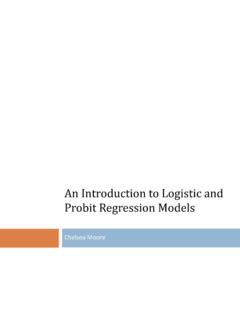
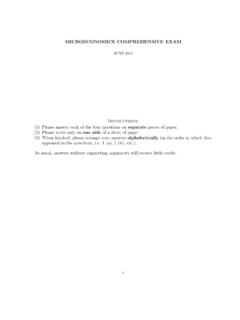
![Letter from Birmingham Jail (1963) [Abridged]](/cache/preview/c/b/b/9/f/7/9/e/thumb-cbb9f79e05a91eb427f1e4c6fe6e1ac5.jpg)
